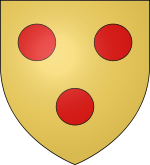- House of Courtenay
-
The House of Courtenay was an important dynasty in medieval France originating from the castle of Courtenay in the Gâtinais (Loiret), going back to the 10th century. The dynasty descended from Athon, the first lord of Courtenay, apparently himself a descendant of the Counts of Sens and from Pharamond, reputed founder of the French monarchy in 420. Athon took advantage of the succession crisis in the Duchy of Burgundy between Otto-William, Duke of Burgundy and Robert II of France to capture a piece of land for himself, where he established his own seigneury, taking his surname from the town he founded and fortified.
The Courtenay family was divided into two branches in the 12th century. The elder branch continued to rule Courtenay, but became extinct around 1150 with the death of Renaud de Courtenay, who had no male descendants. His daughter, Elizabeth, married Peter, a younger son of the Capetian King Louis VI of France. Peter and Elizabeth's descendants hence connected the House of Courtenay with a cadet branch of the House of Capet, and acquired through marriage the County of Namur and the Latin Empire of Constantinople. This branch became extinct in 1730, with the name Courtenay passing on to the Bauffremont family.
The cadet branch of the Courtenay participated in the crusades and came to rule the County of Edessa, a Crusader state; it became extinct around 1200.
In the mid-12th century a branch of the pre-Capetian family settled in England, obtained the barony of Okehampton and inherited the title of Earls of Devon (in 1293) from the de Redvers family (see Baldwin de Redvers). The title was subsequently recreated for Hugh de Courtenay, nephew of Hugh the elder Despenser. Currently the head of this family is Hugh Courtenay, 18th Earl of Devon.
Disputed title
The House of Bourbon, which acquired the French throne with Henry IV of France, was another cadet branch of the Capetian house. Hence, the Courtenay family's male-line descent from Louis VI of France induced the impoverished 17th-century members of the Courtenay family to seek to be acknowledged as "princes du sang" (Princes of the Blood Royal) and "cousins to the king," two titles normally reserved for the members of the royal family and prized for the seats at the Royal Council and the Parliament of Paris that it conferred upon its owners.
Three Bourbon kings in a row - Henri IV, Louis XIII, and Louis XIV - turned down their petitions. That the Bourbon monarchs confined the French royalty to the descendants of Louis IX is evidenced by the Treaty of Montmartre (1662) which named the non-Capetian House of Lorraine as the next in line to the French throne after the Bourbons, thus bypassing the Courtenay, a Capetian family. Although the Courtenays protested this clause, their claims to the princely title were never acknowledged by the Paris Court of Accounts.
The last male member of the French Courtenays committed suicide in 1727, but his sister married the Marquis de Bauffremont, and her descendants assumed the dubious title of Prince de Courtenay, which they bear to this day.
Genealogy
- Athon
- Joscelin I of Courtenay, married 1. Hilegarde of Gatinais (sister of Geoffrey III of Anjou), 2. Elizabeth of Montlhéry, daughter of Guy I of Montlhéry
- Hodierna, married Godfrey II, Count of Joigny
- Miles of Courtenay, married Ermengarde of Nevers
- William of Courtenay
- Joscelin
- Renaud de Courtenay, married Helene of Donjon
- Renaud de Courtenay, married Hawise de Crucy, feudal Lady of Okehampton
- Robert of Okehampton, married Mary de Redvers, d. of William de Redvers, 5th Earl of Devon
- John
- Hugh
- Hugh, 9th Earl of Devon
- Hugh
- John
- Robert of Okehampton, married Mary de Redvers, d. of William de Redvers, 5th Earl of Devon
- Elizabeth, married Peter of Courtenay, son of Louis VI of France
- (Capetian branch)
- Renaud de Courtenay, married Hawise de Crucy, feudal Lady of Okehampton
- Joscelin I, Count of Edessa, married 1. Beatrice (daughter of Constantine I of Armenia), 2. Maria of Salerno (sister of Roger of Salerno)
- Joscelin II, Count of Edessa, married Beatrice
- Joscelin III of Edessa, married Alice of Milly
- Beatrice, married Otho of Henneberg
- Agnes, married William of La Mandelie
- Agnes of Courtenay, married 1. Reginald of Marash, 2. Amalric I of Jerusalem, 3. Hugh of Ibelin, 4. Reginald of Sidon
- Isabella of Courtenay, married Thoros II of Armenia
- Joscelin III of Edessa, married Alice of Milly
- Joscelin II, Count of Edessa, married Beatrice
- Geoffrey Chapalu
- Joscelin I of Courtenay, married 1. Hilegarde of Gatinais (sister of Geoffrey III of Anjou), 2. Elizabeth of Montlhéry, daughter of Guy I of Montlhéry
Bibliography
Categories:- Crusades
- History of Devon
- Capetian dynasty
- House of Courtenay
- 1st house of Courtenay
- Capetian House of Courtenay
- Athon
Wikimedia Foundation. 2010.

